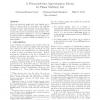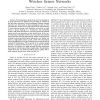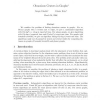148
Voted
SODA
2012
ACM
13 years 2 months ago
2012
ACM
Given an undirected graph with edge lengths and a subset of nodes (called the terminals), the multiway cut (also called the multi-terminal cut) problem asks for a subset of edges,...
135
click to vote
CORR
2012
Springer
13 years 8 months ago
2012
Springer
Let G be a directed graph with n vertices and non-negative weights in its directed edges, embedded on a surface of genus g, and let f be an arbitrary face of G. We describe an alg...
136
Voted
NETWORKS
2011
14 years 3 months ago
2011
A graph is terminal ∆ − Y -reducible if, it can be reduced to a distinguished set of terminal vertices by a sequence of series-parallel reductions and ∆−Y -transformations...
125
Voted
INFOCOM
2011
IEEE
14 years 4 months ago
2011
IEEE
—Extracting planar graph from network topologies is of great importance for efficient protocol design in wireless ad hoc and sensor networks. Previous techniques of planar topol...
111
Voted
CORR
2011
Springer
14 years 7 months ago
2011
Springer
We develop a new technique for computing maximum flow in directed planar graphs with multiple sources and a single sink that significantly deviates from previously known techniqu...
107
click to vote
SIAMDM
2010
14 years 7 months ago
2010
We consider the problem of finding obnoxious centers in graphs. For arbitrary graphs with n vertices and m edges, we give a randomized algorithm with O(n log2 n + m log n) expecte...
129
click to vote
COMBINATORICA
2010
14 years 7 months ago
2010
We prove that the edges of every graph of bounded (Euler) genus can be partitioned into any prescribed number k of pieces such that contracting any piece results in a graph of bou...
125
click to vote
CORR
2011
Springer
14 years 7 months ago
2011
Springer
ABSTRACT. Upon the discovery of power laws [8, 16, 30], a large body of work in complex network analysis has focused on developing generative models of graphs which mimick real-wor...
136
Voted
COMGEO
2011
ACM
14 years 7 months ago
2011
ACM
A set of planar graphs share a simultaneous embedding if they can be drawn on the same vertex set V in the Euclidean plane without crossings between edges of the same graph. Fixed ...
102
Voted
CORR
2010
Springer
14 years 9 months ago
2010
Springer
In the oblivious buy-at-bulk network design problem in a graph, the task is to compute a fixed set of paths for every pair of source-destination in the graph, such that any set of ...



